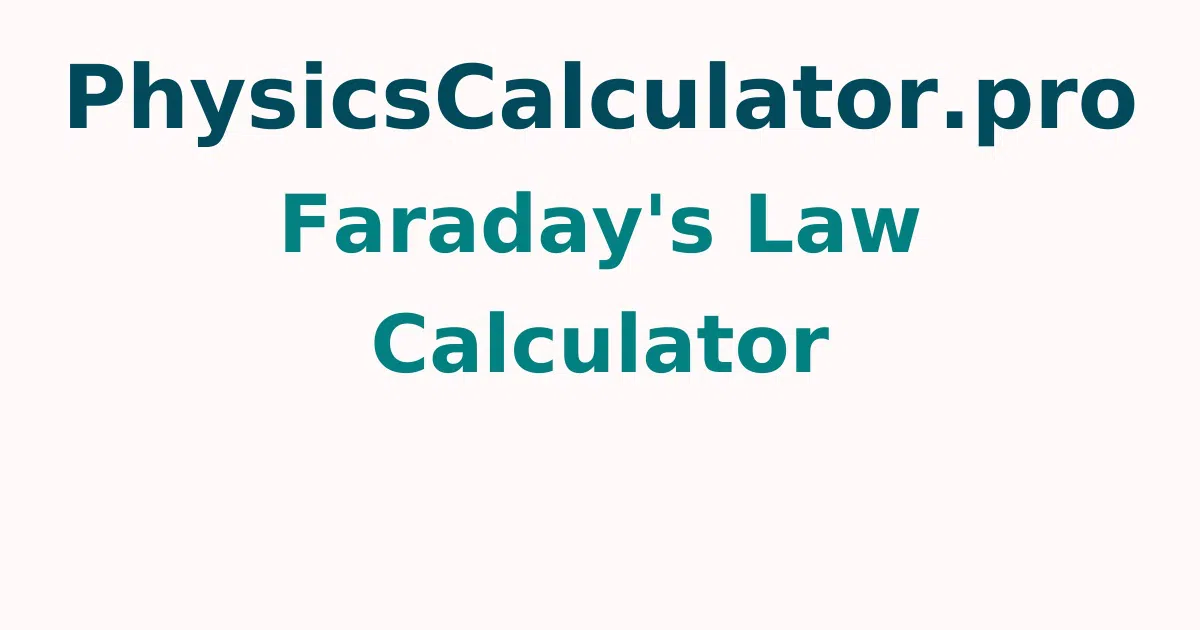Faraday's Law Calculator
Enter the relevant input details into Faraday's Law Calculator to find the induced electromotive force in a circuit quickly and easily. In the specified sections, enter the loop's area, number of turns, magnetic flux, magnetic field, and time, then press the calculate button to see the result.
Magnetic Flux - Definition
The product of the magnetic field and the loop area is called magnetic flux. Φ = B x A
Faraday’s Laws of Electromagnetic Induction
Faraday's Laws of Electromagnetic Induction comprises two laws. The first law describes emf induction in a conductor, while the second law calculates the amount of emf created. Let's take a closer look at this legislation in the following parts.
Faraday’s First Law of Electromagnetic Induction
Faraday and Henry carried out a series of experiments that led to the discovery of electromagnetic induction and its understanding. Faraday deduced from his experiments that when the magnetic flux across the coil changes with time, an emf is induced in the coil. As a result, Faraday's first law of electromagnetic induction has said
An electromotive force is induced whenever a conductor is put in a varying magnetic field. When a conductor circuit is closed, a current is induced, which is known as induced current.
Changing the Intensity of the Magnetic Field in a Closed Loop
A few methods for changing the magnetic field intensity in a closed-loop are listed below
- The coil is rotated with respect to the magnet.
- The coil is inserted and removed from the magnetic field.
- In a magnetic field, by altering the size of a coil.
- A magnet can be moved in front of or behind the coil to achieve this effect.
Faraday’s Second Law of Electromagnetic Induction
The rate of change of flux linkage determines the induced emf in a coil.
The flux is calculated as the product of the coil's number of turns and the flux associated with it. Faraday's law is expressed in the following formula
EMF = - N x dΦ / dt
- Where, N = number of turns in the loop
- dΦ / dt = rate of change of flux
- t = time
- Φ = magnetic flux
For more concepts check out physicscalculatorpro.com to get quick answers by using this free tool.
Lenz’s Law
According to Lenz's law, "The polarity of induced emf is such that it tends to produce a current that opposes the change in magnetic flux that caused it."
This effect is represented by the negative sign in the formula. As a result of the negative sign, the induced emf and the change in the direction of magnetic fields have opposing signs.
How to Calculate Induced EMF?
The procedures to calculate the electromotive force created in a closed circuit are described below. Follow these tips to achieve the desired result.
- Check the loop's area, number of turns, magnetic field, and timing.
- The product of the magnetic field and the area called magnetic flux.
- Divide the flux by the time.
- To check the EMF, multiply the number of turns in the loop through the result.
Examples of Faraday's Law
Question 1: Calculate the magnitude of the induced emf when a magnet is driven into a coil with a 200 cm diameter, 6 turns, a 4 T magnetic field, and a time of 50 seconds.
Solution:
Given: A = 200 cm = 2 m
N = 6
B = 4 T
Magnetic flux Φ = B x A
= 4 x 2 = 8
Induced EMF = - N x dΦ / dt
= -6 x (8/50)
= -0.96
Hence, the induced EMF is -0.96 V
How to Use the Faraday's Law Calculator?
The following is the procedure how to use the Faraday's Law calculator
- Input the unknown's magnetic field strength, area of the loop and x in the appropriate input fields.
- To acquire the result, click the "Calculate the unknown" button.
- Finally, in the output field, the electromotive force of an object will be displayed.
FAQs on Faraday's Law
1. What is the law of Faraday?
Faraday's law is an electromagnetic law that describes how a magnetic field behaves.
2. What is the definition of F electrochemistry?
The magnitude of electric charge per mol of electrons is now known as the Faraday constant, F.
3. How to calculate the electromotive force?
Compute the loop's area, number of turns, magnetic field, flux, and time. The magnetic flux is the product of the magnetic field and the area. The EMF is the ratio of flux change to time divided by the number of turns.
